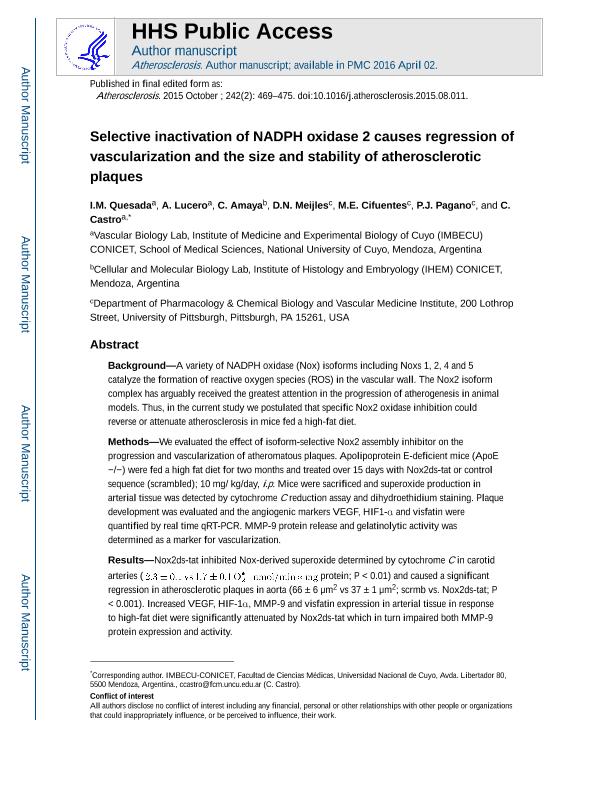Mostrar el registro sencillo del ítem
dc.contributor.author
Quesada, Isabel María

dc.contributor.author
Lucero, Amanda Elisa

dc.contributor.author
Amaya, Celina

dc.contributor.author
Meijles, D. N.
dc.contributor.author
Cifuentes, Maria Eugenia
dc.contributor.author
Pagano, P. J.
dc.contributor.author
Castro, Claudia Magdalena

dc.date.available
2018-03-27T21:30:31Z
dc.date.issued
2015-10
dc.identifier.citation
Quesada, Isabel María; Lucero, Amanda Elisa; Amaya, Celina; Meijles, D. N.; Cifuentes, Maria Eugenia; et al.; Selective inactivation of NADPH oxidase 2 causes regression of vascularization and the size and stability of atherosclerotic plaques; Elsevier Ireland; Atherosclerosis; 242; 2; 10-2015; 469-475
dc.identifier.issn
0021-9150
dc.identifier.uri
http://hdl.handle.net/11336/40290
dc.description.abstract
Background: A variety of NADPH oxidase (Nox) isoforms including Noxs 1, 2, 4 and 5 catalyze the formation of reactive oxygen species (ROS) in the vascular wall. The Nox2 isoform complex has arguably received the greatest attention in the progression of atherogenesis in animal models. Thus, in the current study we postulated that specific Nox2 oxidase inhibition could reverse or attenuate atherosclerosis in mice fed a high-fat diet. Methods: We evaluated the effect of isoform-selective Nox2 assembly inhibitor on the progression and vascularization of atheromatous plaques. Apolipoprotein E-deficient mice (ApoE-/-) were fed a high fat diet for two months and treated over 15 days with Nox2ds-tat or control sequence (scrambled); 10 mg/kg/day, i.p. Mice were sacrificed and superoxide production in arterial tissue was detected by cytochrome C reduction assay and dihydroethidium staining. Plaque development was evaluated and the angiogenic markers VEGF, HIF1-α and visfatin were quantified by real time qRT-PCR. MMP-9 protein release and gelatinolytic activity was determined as a marker for vascularization. Results: Nox2ds-tat inhibited Nox-derived superoxide determined by cytochrome C in carotid arteries (2.3 ± 0.1 vs 1.7 ± 0.1 O2nmol/min*mg protein; P < 0.01) and caused a significant regression in atherosclerotic plaques in aorta (66 ± 6 μm2 vs 37 ± 1 μm2; scrmb vs. Nox2ds-tat; P < 0.001). Increased VEGF, HIF-1α, MMP-9 and visfatin expression in arterial tissue in response to high-fat diet were significantly attenuated by Nox2ds-tat which in turn impaired both MMP-9 protein expression and activity. Conclusion: Given these results, it is quite evident that selective Nox inhibitors can reverse vascular pathology arising with atherosclerosis.
dc.format
application/pdf
dc.language.iso
eng
dc.publisher
Elsevier Ireland

dc.rights
info:eu-repo/semantics/openAccess
dc.rights.uri
https://creativecommons.org/licenses/by-nc-sa/2.5/ar/
dc.subject
Oxidative Stress
dc.subject
Vascular Nox
dc.subject
Vulnerable Plaque
dc.subject.classification
Bioquímica y Biología Molecular

dc.subject.classification
Medicina Básica

dc.subject.classification
CIENCIAS MÉDICAS Y DE LA SALUD

dc.title
Selective inactivation of NADPH oxidase 2 causes regression of vascularization and the size and stability of atherosclerotic plaques
dc.type
info:eu-repo/semantics/article
dc.type
info:ar-repo/semantics/artículo
dc.type
info:eu-repo/semantics/publishedVersion
dc.date.updated
2018-03-27T13:34:58Z
dc.journal.volume
242
dc.journal.number
2
dc.journal.pagination
469-475
dc.journal.pais
Irlanda

dc.journal.ciudad
Shannon
dc.description.fil
Fil: Quesada, Isabel María. Consejo Nacional de Investigaciones Científicas y Técnicas. Centro Científico Tecnológico Conicet - Mendoza. Instituto de Medicina y Biología Experimental de Cuyo; Argentina
dc.description.fil
Fil: Lucero, Amanda Elisa. Consejo Nacional de Investigaciones Científicas y Técnicas. Centro Científico Tecnológico Conicet - Mendoza. Instituto de Medicina y Biología Experimental de Cuyo; Argentina
dc.description.fil
Fil: Amaya, Celina. Consejo Nacional de Investigaciones Científicas y Técnicas. Centro Científico Tecnológico Conicet - Mendoza. Instituto de Histología y Embriología de Mendoza Dr. Mario H. Burgos. Universidad Nacional de Cuyo. Facultad de Cienicas Médicas. Instituto de Histología y Embriología de Mendoza Dr. Mario H. Burgos; Argentina
dc.description.fil
Fil: Meijles, D. N.. University of Pittsburgh; Estados Unidos
dc.description.fil
Fil: Cifuentes, Maria Eugenia. University of Pittsburgh; Estados Unidos
dc.description.fil
Fil: Pagano, P. J.. University of Pittsburgh; Estados Unidos
dc.description.fil
Fil: Castro, Claudia Magdalena. Consejo Nacional de Investigaciones Científicas y Técnicas. Centro Científico Tecnológico Conicet - Mendoza. Instituto de Medicina y Biología Experimental de Cuyo; Argentina
dc.journal.title
Atherosclerosis

dc.relation.alternativeid
info:eu-repo/semantics/altIdentifier/doi/http://dx.doi.org/10.1016/j.atherosclerosis.2015.08.011
dc.relation.alternativeid
info:eu-repo/semantics/altIdentifier/url/http://www.atherosclerosis-journal.com/article/S0021-9150(15)30074-5/fulltext
Archivos asociados
